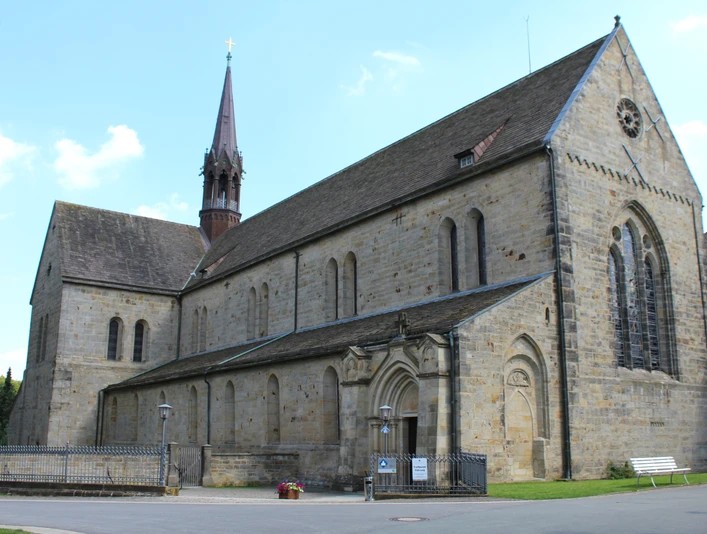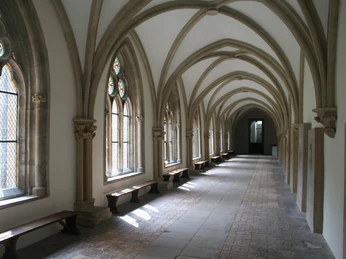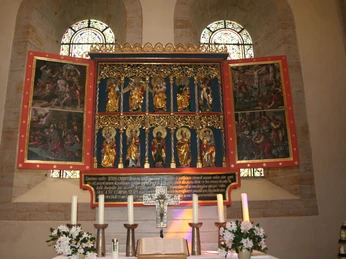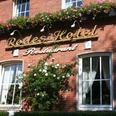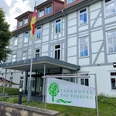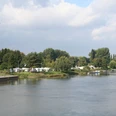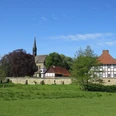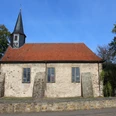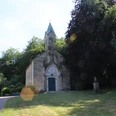- Photos & Map
How would you like to arrive?
- Call
- Description
- Good to know
- Nearby
A visit to the monastery, which was built in 1163, proves the motto and allows guests to travel back in time. Unique in its effect, it still conveys the impression of a medieval Cistercian monastery. The impressive surroundings with ponds and forest, on the other hand, owe their effect to the hydraulic engineering of the Cistercians and the landscaping of the early 19th century.
The monastery was founded by twelve young monks from Thuringia and their abbot, who wanted to live in poverty in seclusion - also as a protest against the pomp of the church - solely from the work of their hands. Their church was not intended to be a cathedral, but a simple house of prayer. The Cistercians' sense of austerity and simplicity can be seen in the sparse and geometric form of the building. The monastery complex is largely unchanged; in addition to the dining hall and library, the cloister and the monastery church are particularly noteworthy. The latter boasts a number of valuable works of art (reliquary, choir stalls) and is also a frequent venue for excellent concerts. The collegiate church "Maria und Georg" is still the church of the monastery and also the parish church. In the summer months, the church is also open to visitors outside of guided tours. The cloister and other sights can be seen during a 60-minute guided tour for a fee. In addition to books, goods from all over the world are also available in the monastery parlor - for example tea, coffee and cakes. The Loccum-Volkenroda and Loccum-Mariensee-Loccum pilgrimage routes also start here. It is also on the Sigwardsweg pilgrimage route.
The monastery, which was founded in the deepest (and swampiest) solitude at the time, is still very much alive today in many respects: In addition to the conference center, the monastery houses a Protestant preacher's seminary, and it also serves as an internationally renowned venue for specialist conferences.
Loccum Monastery is part of the Cistercian Cultural Landscapes, an association of seventeen European Cistercian monasteries (www.cisterscapes.eu). Together they bear the European Heritage Label. This seal recognizes their key role in European history and culture. A 6340 kilometer long cultural hiking trail connects the individual monasteries. There is also a small monastery landscape trail (half-day tour) and a large monastery landscape trail (day tour).
Civil weddings are possible in the refectory of the monastery.
The monastery was founded by twelve young monks from Thuringia and their abbot, who wanted to live in poverty in seclusion - also as a protest against the pomp of the church - solely from the work of their hands. Their church was not intended to be a cathedral, but a simple house of prayer. The Cistercians' sense of austerity and simplicity can be seen in the sparse and geometric form of the building. The monastery complex is largely unchanged; in addition to the dining hall and library, the cloister and the monastery church are particularly noteworthy. The latter boasts a number of valuable works of art (reliquary, choir stalls) and is also a frequent venue for excellent concerts. The collegiate church "Maria und Georg" is still the church of the monastery and also the parish church. In the summer months, the church is also open to visitors outside of guided tours. The cloister and other sights can be seen during a 60-minute guided tour for a fee. In addition to books, goods from all over the world are also available in the monastery parlor - for example tea, coffee and cakes. The Loccum-Volkenroda and Loccum-Mariensee-Loccum pilgrimage routes also start here. It is also on the Sigwardsweg pilgrimage route.
The monastery, which was founded in the deepest (and swampiest) solitude at the time, is still very much alive today in many respects: In addition to the conference center, the monastery houses a Protestant preacher's seminary, and it also serves as an internationally renowned venue for specialist conferences.
Loccum Monastery is part of the Cistercian Cultural Landscapes, an association of seventeen European Cistercian monasteries (www.cisterscapes.eu). Together they bear the European Heritage Label. This seal recognizes their key role in European history and culture. A 6340 kilometer long cultural hiking trail connects the individual monasteries. There is also a small monastery landscape trail (half-day tour) and a large monastery landscape trail (day tour).
Civil weddings are possible in the refectory of the monastery.
Good to know
Openings
Eligibility
Bad Weather Offer
Suitable for any weather
for Groups
for individual guests
Contact person
Author
Mittelweser-Touristik GmbH
Lange Straße 18
31582 Nienburg/Weser
Organization
Mittelweser-Touristik GmbH
License (master data)
Mittelweser-Touristik GmbH
Nearby
